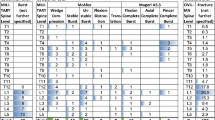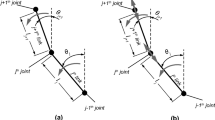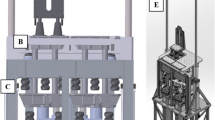Abstract
High-amplitude biodynamic responses may occur when the human body is subjected to a vertical impact load induced by explosions or crashes. In order to improve the occupant protection capability of a vehicle, numerical calculation should be accomplished to obtain body responses via an accurate anthropomorphic model during the design stage. In this study, a nonlinear two-dimensional multi-body ‘occupant-restraint system’ model was developed to predict the dynamic response characteristics of a seated human under a vertical load. A four-point harness was introduced to simulate the restraint effect on the human body. Parameters of the multi-body model were optimized based on the Error Assessment of Response Time Histories (EARTH) metric and data from drop tower tests. Errors between experimental and numerical results about the peak value and the duration of main peak were 9.2% and 12.7%, respectively. To improve the practicality of the constructed model, a buffer device, which could control the load transmitted to the torso, was then implanted in the seat to study the regular pattern among the lumbar force, cushion force, and cushion stroke. With low computation cost, the model showed the ability of assessing and reducing occupant injuries and guiding the matching process between the cushion element and seat system.





















Similar content being viewed by others
Availability of data and material
Test data files are not available because of their confidentiality.
Code availability
Not available.
References
Khan, M.T., Husain, F.N., Ahmed, A.: Hindfoot injuries due to landmine blast accidents. Injury 33, 167–171 (2002). https://doi.org/10.1016/S0020-1383(01)00092-4
Zhang, X., Zhou, Y., Wang, X., Wang, Z.: Modelling and analysis of the vehicle underbody and the occupants subjected to a shallow-buried-mine blast impulse. Proc. Inst. Mech. Eng. Part D J. Automob. Eng. 231, 214–224 (2017). https://doi.org/10.1177/0954407016651353
Cheng, M., Dionne, J., Makris, A.: On drop-tower test methodology for blast mitigation seat evaluation. Int. J. Impact Eng. 37, 1180–1187 (2010). https://doi.org/10.1016/j.ijimpeng.2010.08.002
Liang, C.-C., Chiang, C.-F.: A study on biodynamic models of seated human subjects exposed to vertical vibration. Int. J. Ind. Ergon. 36, 869–890 (2006). https://doi.org/10.1016/j.ergon.2006.06.008
Liu, X.X., Shi, J., Li, G.H.: Biodynamic response and injury estimation of ship personnel to ship shock motion induced by underwater explosion. Proceeding 69th Shock Vib. Symp. 18, 1–18 (1998)
Zong, Z., Lam, K.Y.: Biodynamic response of shipboard sitting subject to ship shock motion. J. Biomech. 35, 35–43 (2002). https://doi.org/10.1016/S0021-9290(01)00167-1
Singh, H.J., Wereley, N.M.: Biodynamic model of a seated occupant exposed to intense impacts. AIAA J. (2004). https://doi.org/10.2514/1.J053193
Pascoletti, G., Catelani, D., Conti, P., Cianetti, F., Zanetti, E.M.: Multibody models for the analysis of a fall from height: accident, suicide, or murder? Front. Bioeng. Biotechnol. 7, 419 (2019). https://doi.org/10.3389/fbioe.2019.00419
Cheng, M., Bueley, D., Chin, L., Dionne, J., Wright, N., Makris, A.: Evaluation of ATD models for simulating occupant responses under vertical impact. In: 13th Int. LS-DYNA Users Conf (2014)
Li, N., Fang, H., Zhang, C., Gutowski, M., Palta, E., Wang, Q.: A numerical study of occupant responses and injuries in vehicular crashes into roadside barriers based on finite element simulations. Adv. Eng. Softw. 90, 22–40 (2015). https://doi.org/10.1016/j.advengsoft.2015.06.004
Barbeau, R., Weisser, T., Dupuis, R., Aubry, É., Baudu, S.: Assessment of the impact of sub-components on the dynamic response of a coupled human body/automotive seat system. J. Sound Vib. (2019). https://doi.org/10.1016/j.jsv.2019.07.012
Kim, T.H., Kim, Y.T., Yoon, Y.S.: Development of a biomechanical model of the human body in a sitting posture with vibration transmissibility in the vertical direction. Int. J. Ind. Ergon. 35, 817–829 (2005). https://doi.org/10.1016/j.ergon.2005.01.013
Zaseck, L.W., Orton, N.R., Gruber, R., Scherer, R., Reed, M., Hu, J., Wood, L., Orton, N.R., Gruber, R., Rupp, J., Wood, L., Ritchie, N., Gruber, R., Rupp, J., Scherer, R., Reed, M.: The influence of personal protection equipment, occupant body size, and restraint system on the frontal impact responses of Hybrid III ATDs in tactical vehicles: The influence of personal protection equipment, occupant body size, and restraint. Traffic Inj. Prev. 18, 642–649 (2017). https://doi.org/10.1080/15389588.2017.1282156
Hu, D.Y., Yang, J.L., Hu, M.H.: Full-scale vertical drop test and numerical simulation of a crashworthy helicopter seat/occupant system. Int. J. Crashworthiness. 14, 565–583 (2009). https://doi.org/10.1080/13588260902896433
Shukla, N.: Analysis of the articulated total body (ATB) and mathematical dynamics model (MADYMO) software suites for modeling anthropomorphic test devices (ATDs) in blast environments (2013)
Clendening, H.: Reusable material for drop tower. Kettering University Theses, Dissertations (2011)
NATO-RTO.: Test methodology for protection of vehicle occupants against anti-vehicular landmine effects. North Atlantic Treaty Organization Research and Technology Organisation No. TR-HMF-090, France (2007)
Eridon J, Cory J. Blast survivability and seat drop tower testing. 2011 NDIA Ground Vehicle Systems Engineering and Technology. Dearborn, Michigan (2011)
Kaleps, I., Whitestone, J.: Hybrid III Geometrical and Inertial Properties. In: SAE International Congress and Exposition. SAE International (1988)
Guha, S.: LSTC_NCAC Hybrid III 50th Dummy Positioning and Post-Processing. Lstc. (2014)
Liang, C.C., Chiang, C.F.: Modeling of a seated human body exposed to vertical vibrations in various automotive postures. Ind. Health. 46, 125–137 (2008). https://doi.org/10.2486/indhealth.46.125
Ma, D., Obergefell, L.A., Rizer, A.L.: Development of human articulating joint model parameters for crash dynamics simulations. SAE Tech. Pap. (1995). https://doi.org/10.4271/952726
Teng, T.L., Chang, F.A., Liu, Y.S., Peng, C.P.: Analysis of dynamic response of vehicle occupant in frontal crash using multibody dynamics method. Math. Comput. Model. 48, 1724–1736 (2008). https://doi.org/10.1016/j.mcm.2007.10.020
Pascoletti, G., Catelani, D., Conti, P., Cianetti, F., Zanetti, E.M.: A multibody simulation of a human fall: Model creation and validation. Procedia Struct. Integr. 24, 337–348 (2019). https://doi.org/10.1016/j.prostr.2020.02.031
Freidenberg, A., Lee, C.W., Durant, B., Nesterenko, V.F., Stewart, L.K., Hegemier, G.A.: Characterization of the Blast Simulator elastomer material using a pseudo-elastic rubber model. Int. J. Impact Eng. 60, 58–66 (2013). https://doi.org/10.1016/j.ijimpeng.2013.04.009
Kang, S., Chen, C., Guha, S., Paladugu, M., Sundaram, M., Gade, L., Zhu, F.: LS-DYNA ® belted occupant model. Int. LS-Dyna Users Conf. 1–11 (2018)
Aggromito, D., Jaffrey, M., Chhor, A., Chen, B., Yan, W.: Effects of lumbar spine assemblies and body-borne equipment mass on anthropomorphic test device responses during drop tests. J. Biomech. Eng. 139, 1–8 (2017). https://doi.org/10.1115/1.4037401
Sarin, H., Kokkolaras, M., Hulbert, G., Papalambros, P., Barbat, S., Yang, R.-J.: A comprehensive metric for comparing time histories in validation of simulation models with emphasis on vehicle safety applications, https://doi.org/10.1115/DETC2008-49669 (2008)
Liu, X., Chen, W., Paas, M.: Automated occupant model evaluation and correlation. Proceedings of the ASME 2005 international mechanical engineering congress and exposition, pp. 353–358 (2005). https://doi.org/10.1115/IMECE2005-81258
Assent, I., Wichterich, M., Krieger, R., Kremer, H., Seidl, T.: Anticipatory DTW for efficient similarity search in time series databases. Proc. VLDB Endow. 2, 826–837 (2009). https://doi.org/10.14778/1687627.1687721
Deb, K., Pratap, A., Agarwal, S., Meyarivan, T.: A fast and elitist multiobjective genetic algorithm: NSGA-II. IEEE Trans. Evol. Comput. 6, 182–197 (2002). https://doi.org/10.1109/4235.996017
ESTECO. modeFRONTIER User Guide: Version 4.4.3. ESTECO S.p.A (2013)
Zheng, Q., Wei, R., Li, M., Wang, X., Zhou, D., Fu, T.: Occupant’s lower extremities’ impact-based model calibration for vehicle under-belly blast. Struct. Multidiscip. Optim. (2020). https://doi.org/10.1007/s00158-020-02668-3
Desai, R., Guha, A., Seshu, P.: Multibody biomechanical modelling of human body response to vibrations in an automobile. In: Uhl, T. (ed.) Advances in mechanism and machine science, pp. 3–12. Springer, Cham (2019)
Desjardins, S.P.: The evolution of energy absorption systems for crashworthy helicopter seats. J. Am. Helicopter Soc. 51, 150–163 (2009). https://doi.org/10.4050/jahs.51.150
Ladkany GS. Design and characterization of a shock and vibration mitigation seat system. UNLV Theses, Dissertations (2009). https://doi.org/10.34917/1394606
Zhou, D., Wang, X., Zhou, Y., Sun, X., Zhang, J.: Experimental and numerical investigations on the energy-absorption of a bending-straightening structure. Int. J. Crashworthiness. (2020). https://doi.org/10.1080/13588265.2019.1709337
Federal Aviation Authority: 14 CFR Part 27: Airworthiness Standards: Normal Category Rotorcraft: Emergency Landing Dynamic Conditions”, FAA Code of Federal Regulations. U.S. Government Publishing office, Washington, DC (1958)
Acknowledgements
This work was supported by the National Natural Science Foundation of China (Grant No. 11802140). The authors would like to acknowledge Nanjing University of Science and Technology (NJUST) Vehicle Engineering institute for test and equipment support, and LetPub for its linguistic assistance during the preparation of this manuscript.
Funding
The National Natural Science Foundation of China [grant numbers: 11802140].
Author information
Authors and Affiliations
Contributions
All authors contributed to the study conception and design. Material preparation, data collection and analysis were performed by Di Zhou, Xianhui Wang and Qichen Zheng. The first draft of the manuscript was written by Di Zhou, and all authors commented on previous versions of the manuscript. All authors read and approved the final manuscript.
Corresponding author
Ethics declarations
Conflicts of interest
The authors declare that they have no known competing financial interests or personal relationships that could have appeared to influence the work reported in this paper.
Additional information
Publisher's Note
Springer Nature remains neutral with regard to jurisdictional claims in published maps and institutional affiliations.
Rights and permissions
About this article
Cite this article
Zhou, D., Wang, X., Zheng, Q. et al. A nonlinear occupant-restraint system model for predicting human injuries caused by vertical impact. Nonlinear Dyn 105, 3093–3115 (2021). https://doi.org/10.1007/s11071-021-06490-4
Received:
Accepted:
Published:
Issue Date:
DOI: https://doi.org/10.1007/s11071-021-06490-4




